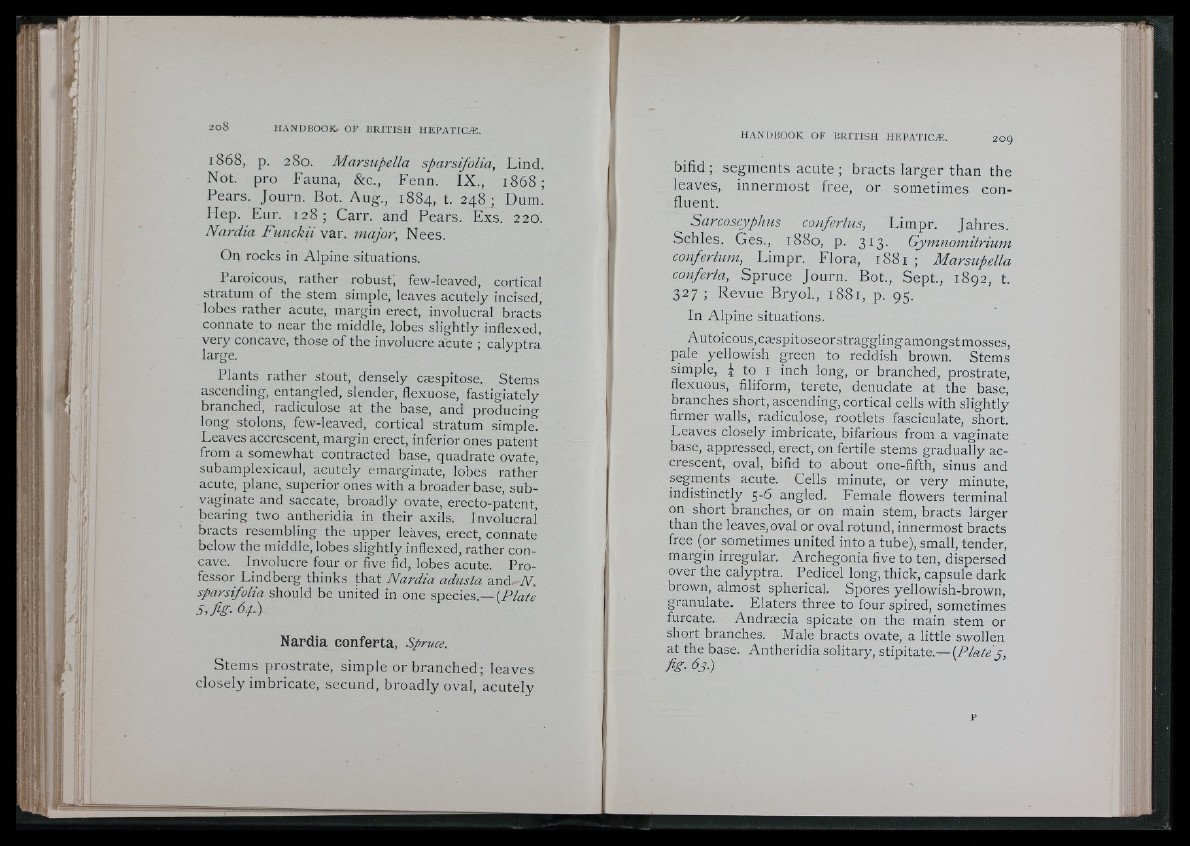
f
\Æ
1868, p. 280. Marsupella sparsifolia, Lind.
Not. pro Fauna, &c., Fenn. IX., 18 68;
Pears. Journ. Bot. Aug ., 1884, t- 2 48 ; Dum.
Hep. Eur. 12 8 ; Carr. and Pears. Exs. 220.
Nardia Fun ck ii var. major, Nees.
On rocks in Alpine situations.
Paroicous, rather robust) few-leaved, cortical
stratum of the stem simple, leaves acutely incised,
lobes rather acute, margin erect, involucral bracts
connate to near the middle, lobes slightly inflexed,
very concave, those of the involucre acute ; calyptra
large.
Plants rather stout, densely cæspitose. Stems
ascending, entangled, slender, flexuose, fastigiately
branched, radiculose at the base, and producing
long stolons, few-leaved, cortical stratum simple.
Leaves accrescent, margin erect, inferior ones patent
from a somewhat contracted base, quadrate ovate,
subamplexicaul, acutely emarginate, lobes rather
acute, plane, superior ones with a broader base, sub-
vaginate and saccate, broadly ovate, erccto-patent,
bearing two antheridia in their axils. Involucral’
bracts resembling the upper leaves, erect, connate
below the middle, lobes slightly inflexed, rather concave.
Involucre four or five fid, lobes acute. Professor
Lindberg thinks that Nardia adusia and ■TP.
sparsifolia should be united in one species.— (P/æ/î?
5, jig. 64)
Nardia conferta, Spruce.
Stems prostrate, simple or branched; leaves
c losely imbricate, secund, broadly oval, acutely
bifid ; segments acute ; bracts larger than the
leaves, innermost free, or somet imes confluent.
Sarcoscyphus confertus, Limpr. Jahres.
Schles . Ges,, 1880, p. 313. Gymnomitrium
confertmn, Limpr. Flora, 1881 ; Marsupella
conferta. S p ru c e Journ. Bot., Sept., 1892, t.
3 2 7 ; Re v u e Bryol., 1881, p. 95.
In Alpine situations.
Autoicous,cæspitoseorstragglingamongstmosses,
pale yellowish green to reddish brown. Stems
simple, J to I inch long, or branched, prostrate,
flexuous, filiform, terete, denúdate at the base,
branches short, ascending, cortical cells with slightly
firmer walls, radiculose, rootlets fasciculate, short.
Leaves closely imbricate, bifarious from a vaginate
base, appressed, erect, on fertile stems gradually accrescent,
oval, bifid to about one-fifth, sinus and
segments acute. Cells minute, or very minute,
indistinctly 5-6 angled. Female flowers terminal
on short branches, or on main stem, bracts larger
than the leaves, oval or oval rotund, innermost bracts
free (or sometimes united into a tube), small, tender,
margin irregular. Archegonia five to ten, dispersed
over the calyptra. Pedicel long, thick, capsule dark
brown, almost spherical. Spores yellowish-brown,
granulate. Elaters three to four spired, sometimes
furcate. Andræcia spicate on the main stem or
short branches. Male bracts ovate, a little swollen
at the base. Antheridia solitary, stipitate.— [Plate g ,
fig- 63-)
■'Vii''
I ,
I )
.Í ,